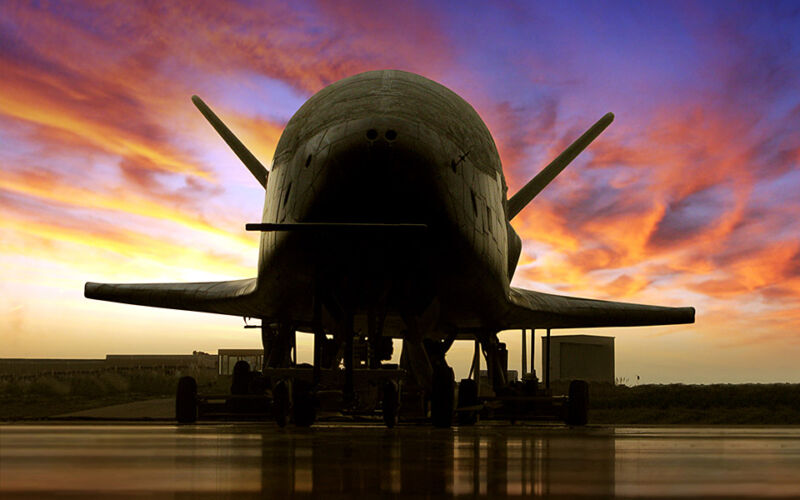It turns out some of the informed speculation about the US military’s latest X-37B spaceplane mission was pretty much spot-on.
When the semi-classified winged spacecraft launched on December 28, it flew into orbit on top of a SpaceX Falcon Heavy rocket, which is much larger than the Atlas V and Falcon 9 rockets used to launch the X-37B on its previous missions.
This immediately sparked speculation that the X-37B would reach higher altitudes than its past flights, which remained in low-Earth orbit at altitudes of a few hundred miles. A discovery from Tomi Simola, a satellite tracking hobbyist living near Helsinki, Finland, appears to confirm this suspicion.
On Friday, Simola reported on social media and on SeeSat-L, a long-running online forum of satellite tracking enthusiasts, that he detected an unidentified object using a sky-watching camera. The camera is designed to continuously observe a portion of the sky to detect moving objects in space. A special software program helps identify known and unknown objects.
“Exciting news!” Simola posted on social media. “Orbital Test Vehicle 7 (OTV-7), which was launched to classified orbit last December, was seen by my SatCam! Here are images from the last two nights!”
Exciting news!
Orbital Test Vehicle 7 (OTV-7), which was launched to classified orbit last December, was seen by my SatCam!
Here are images from the last two nights! pic.twitter.com/3twOVdovVc
— Tomppa 🇺🇦 (@tomppa77) February 9, 2024
Mike McCants, one of the more experienced satellite observers and co-administrator of the SeeSat-L forum, agreed with Simola’s conclusion that he found the X-37B spaceplane.
“Congrats to Tomi Simola for locating the secret X-37B spaceplane,” posted Jonathan McDowell, an astrophysicist and widely respected expert in spaceflight activity.
Higher than ever
Amateur observations of the spaceplane indicate it is flying in a highly elliptical orbit ranging between 201 and 24,133 miles in altitude (323 and 38,838 kilometers). The orbit is inclined 59.1 degrees to the equator.
This is not far off the predictions from the hobbyist tracking community before the launch in December. At that time, enthusiasts used information about the Falcon Heavy’s launch trajectory and drop zones for the rocket’s core booster and upper stage to estimate the orbit it would reach with the X-37B spaceplane.
The Space Force has not released any information about the orbit of the X-37B. While it took hobbyists about six weeks to find the X-37B on this mission, it typically took less time for amateur trackers to locate it when it orbited at lower altitudes on its previous missions. Despite the secrecy, it’s difficult to imagine the US military’s adversaries in China and Russia didn’t already know where the spaceplane was flying.
Military officials usually don’t disclose details about the X-37B’s missions while they are in space, providing updates only before each launch and then after each landing.
This is the seventh flight of an X-3B spaceplane since the first one launched in 2010. In a statement before the launch in December, the Space Force said this flight of the X-37B is focused on “a wide range of test and experimentation objectives.” Flying in “new orbital regimes” is among the test objectives, military officials said.
The military has two Boeing-built X-37B spaceplanes, or Orbital Test Vehicles, in its inventory. They are reusable and designed to launch inside the payload fairing of a conventional rocket, spend multiple years in space with the use of solar power, and then return to Earth for a landing on a three-mile-long runway, either at Vandenberg Space Force Base in California or at NASA’s Kennedy Space Center in Florida.
It resembles a miniature version of NASA’s retired space shuttle orbiter, with wings, deployable landing gear, and black thermal protection tiles to shield its belly from the scorching heat of reentry. It measures 29 feet (about 9 meters) long, roughly a quarter of the length of NASA’s space shuttle, and it doesn’t carry astronauts.
The X-37B has a cargo bay inside the fuselage for payloads, with doors that open after launch and close before landing. There is also a service module mounted to the back end of the spaceplane to accommodate additional experiments, payloads, and small satellites that can deploy in orbit to perform their own missions.
All the Space Force has said about the payloads on the current X-37B flight is that its experiment package includes investigations into new “space domain awareness technologies.” NASA is flying an experiment on the X-37B to measure how plant seeds respond to sustained exposure to space radiation. The spaceplane’s orbit on this flight takes it through the Van Allen radiation belts.
The secrecy surrounding the X-37B has sparked much speculation about its purpose, some of which centers on ideas that the spaceplane is part of a classified weapons platform in orbit. More likely, analysts say, the X-37B is a testbed for new space technologies. The unusual elliptical orbit for this mission is similar to the orbit used for some of the Space Force’s satellites designed to detect and warn of ballistic missile launches.
McDowell said this could mean the X-37B is testing out an infrared sensor for future early warning satellites, but then he cautioned this would be “just a wild speculation.”
Speculation is about all we have to go on regarding the X-37B. But it seems we no longer need to speculate about where the X-37B is flying.
